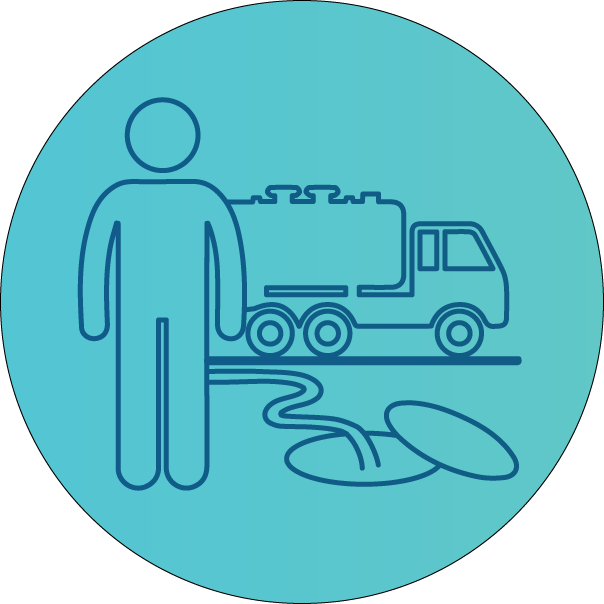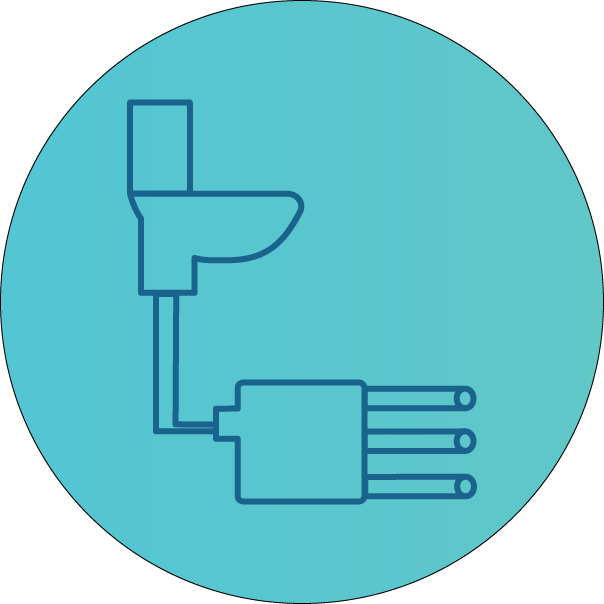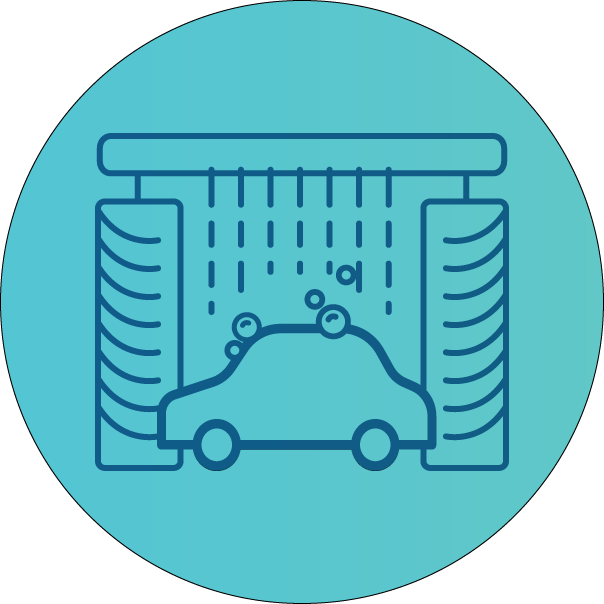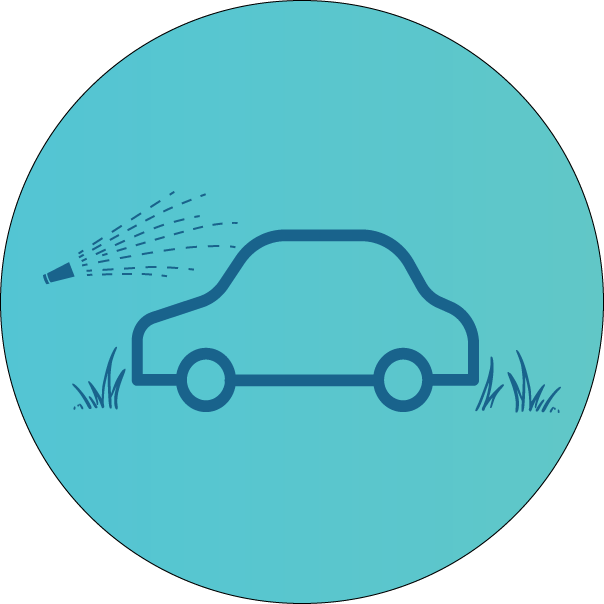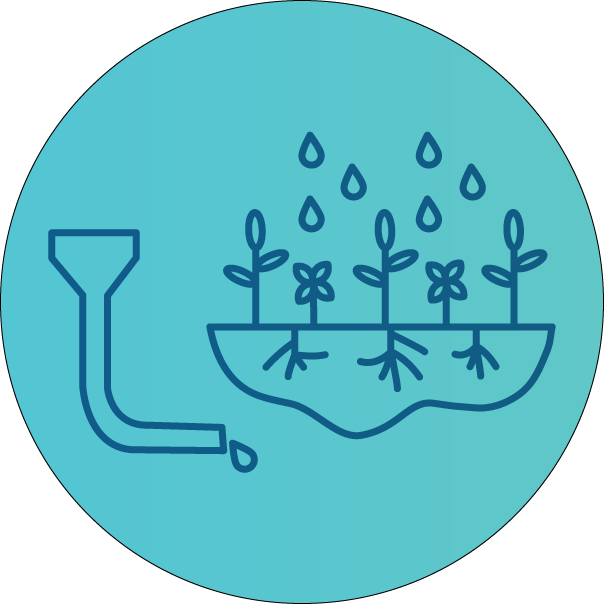
The way we manage the land impacts local waterbodies. Learn how you can responsibly manage your land and encourage responsible management in your community!
Model and Encourage Responsible Land Management
Protect wetlands by building in upland areas. Wetlands recharge groundwater, provide wildlife habitat, filter pollutants, and mitigate flooding. Reduce the density of development, including paved areas, in wetlands.
If you live along a waterbody, protect the riparian area. The riparian area is the interface between the land and the water, and it is important for preventing erosion. Here are some tips to help you protect the riparian zone and responsibly manage your waterfront property:
- Always maintain deep-rooted vegetation along water’s edge and avoid mowing along water’s edge to prevent loss of essential root mass.
- Avoid building too close to the water’s edge and on the outer edge of river bends where erosion is more likely.
- To maintain your view, plant tall, deep-rooting species along the sides of your view and shorter plants in the middle.
- Build on upland areas and use permeable paths (made from wood, stone, or gravel) for access to the water.
- If you have livestock, prevent damage to riparian areas by using fencing for short-term grazing or installing water gaps, hardened crossings, or offsite water.
Encourage responsible land management in your community by attending public meetings held by your county commissioners and planning boards. Learn how your community plans to develop and speak out to encourage responsible, sustainable land management.

The things you do on your lawn have an impact on your watershed. What, where, and how you garden matter for water quality and aquatic health. Learn how you can implement watershed-friendly gardening tips!
Use Watershed-Friendly Landscaping Practices
Apply fertilizers and pesticides sparingly. Fertilizers contain nutrients that can cause algal growth, and pesticides and herbicides can contain toxins that are harmful to aquatic life. When use is necessary, do not exceed recommended amounts. Extra fertilizers and pesticides applied to lawns and gardens wash off and pollute local waterways.
Be mindful of your water use and adopt practices to conserve water. Water is a precious resource that needs to be conserved. Here are some tips to help you use less water in your garden:
- Water when the temperature is cool to prevent water loss from evaporation.
- Plant drought-tolerant, native plants that naturally need less water
- Use mulch to maintain soil moisture and driplines to target watering to specific plants.Use a “step-test” to determine when your lawn needs watered.
- Repair and maintain spigots, hoses, and sprinklers to prevent water loss from leaks.
Use a diversity of plants in your garden. Pollinators such as insects and birds require a food source throughout the year, so use plants with different bloom times in your garden. Having diverse plant types—including trees, shrubs, and grasses—mimics the natural environment and can provide habitat for pollinators and small wildlife.

Aquatic plants need nutrients to survive, but in elevated concentrations nutrients can negatively impact waterbodies, often through the creation of harmful algal blooms (HABs). HABs are an overgrowth of a type of algae, known as cyanobacteria, in water that can affect water quality and aquatic life. Some cyanobacteria can create toxins that may harm people and animals. Learn about different sources of nutrients and how you can help prevent nutrient pollution!
Protect Against Nutrient Pollution
1
Keep leaves and grass off streets, storm drains, and sidewalks.
When fallen leaves and grass clippings get into storm drains, they can become clogged, potentially flooding our streets, and sending pollutants to our local streams and rivers. Excess leaves, grass clippings, and fertilizers/pesticides in streams can cause elevated levels of nutrients and lower oxygen levels in water, potentially harming aquatic life.
2
Pick up, bag, and throw pet waste in the trash.
When pet waste is left on the ground in public or at home, bacteria and excess nutrients can wash into storm drains and eventually into local waterbodies. In addition to nutrients, pet waste can contain disease-causing organisms, and when it enters our local rivers and streams it increases public and aquatic life health risks.
3
Keep an eye on your local waterbodies and report any oddities.
Because water management agencies and conservation groups cannot be everywhere all the time, they rely on citizens to report issues on their lakes. Things like harmful algal blooms (HABs) are regularly discovered by recreators and waterfront property owners. Use caution during an HAB event (or a potential HAB event) as your health can be impacted when you are near, consume, or swim in the water.
Click to learn more about harmful algal blooms, how to identify them, and to report suspected sightings! We need your help to keep your community safe from HABs!

Aquatic invasive species (AIS) can reproduce quickly and spread rapidly. AIS—such as zebra and quagga mussels, Eurasian watermilfoil, and flowering rush—can displace native species, clog waterways, impact irrigation and hydropower systems, degrade ecosystems, threaten recreational opportunities, and cause wildlife and public health problems. While recreating on Montana Waters, it’s important to understand and lessen your impacts on waterbodies. Learn how you can be a responsible recreator and stop the spread of AIS!
Recreate Responsibly
1
Ensure your watercraft and gear are cleaned, drained, and dried and stop at all open watercraft inspection stations when recreating on Montana Waters. AIS can travel from waterbody to waterbody on your watercraft, waders, and gear. It’s important to ensure any items you plan to bring into the water are clean and free of AIS.
2
Reduce boat wakes when wake surfing, wake boarding, and engaging in other water sports by observing no wake zones and keeping your wake to a minimum within 500 feet from the shoreline. Wake boats generate a large surfing wave that hits the shoreline with immense energy. Increased shoreline erosion because of this recreation has caused shoreline erosion for landowners who are losing large portions of their property and experiencing reduced water clarity and safety.
3
Prevent oil and gas spills by using absorbent fuel bibs when refueling your watercraft and other gas-powered vehicles.
To learn more about AIS and to report any suspected AIS sightings, visit the Montana Fish, Wildlife and Parks website! We need your help to prevent AIS in Montana!
Approximately 40% of homes in Montana utilize onsite wastewater treatment systems, otherwise known as septic systems. These underground systems separate solids in wastewater from the liquid, known as leachate. Leachate is slowly released in the ground to be treated by microbes in the soil. Septic leachate can pollute surface and groundwater and pose risks to community health when they are improperly designed, sited, operated, or maintained. Learn how you can reduce septic leachate pollution by being a responsible septic system owner!
Be a Responsible Septic System Owner
Maintain your septic system with annual inspections and pumping as needed. To keep your septic system performing its best, the U.S. EPA recommends getting your system pumped every 3-5 years depending on usage. Annual inspections can give you peace of mind that your system is functioning well and identify potential problems early before they lead to failure. You can protect your environment, health, and bottom line by regularly inspecting and pumping your septic system!
Learn about your septic system and what items can and cannot be flushed down the drain. Overusing harsh chemicals can kill the good bacteria in your septic tank that digests and breaks down waste. Certain paper products can also harm your system if you flush them down your toilet, including sanitary products, baby wipes, and tissues. Research the dos and don’ts of responsible septic system care to keep your system functioning at its best and save you maintenance costs later!

Stormwater is runoff that flows across the hard surfaces on the landscape, including roadways, rooftops, and compacted soil. Here in Montana, stormwater flows into surface waterbodies, often without treatment. Unregulated stormwater discharges are a type of nonpoint source pollution, meaning that sources of stormwater pollution are often unidentifiable and dispersed across the landscape. Learn how you can reduce stormwater pollution by being mindful of what you leave on the landscape!
Reduce Stormwater Pollution
Use a commercial car wash to wash your vehicles and other equipment. At a commercial car wash, the wash water drains to the sanitary sewer where the water is treated. However, when you wash your car in your driveway, the dirty water enters storm drains that discharge directly to local waterbodies. Dirty car wash water often contains oil, grease, and toxic metals. Soapy water and the chemicals in many detergents are harmful to fish and other aquatic life.
Wash your car on grass or in an area where water can filter into the ground and not run off to the storm drain. If your driveway drains to a vegetated area and not the storm drain, that works too. Divert the wash water drainage away from storm drains. To reduce possible runoff from the grassy area, use a hose with a shut-off valve. Dump soapy water in a sink or an area where it will filter into the ground.
Install a rain garden on your property. Rain gardens are bowl-shaped gardens that filter oil and grease from driveways, fertilizers, and pesticides from lawns before they reach groundwater or the storm drain. They also enhance the landscaping and appearance of yards, provide habitat for birds and insects, reduce flooding and erosion in streams, and improve local groundwater recharge by helping water soak into the ground.
Responsibly dispose of household hazardous products, such as paints, pesticides, insecticides, motor oil, and pharmaceuticals at a collection facility. Don’t pour them onto the ground or into storm drains, sinks, or toilets. For small spills, sprinkle with sawdust or kitty litter, seal in a trash bag, and put in the trash. For large spills call your county emergency services or 911.

Get involved in volunteer opportunities! One of the greatest ways to act now is to get involved volunteering for a local watershed organization.
There are ample opportunities to volunteer in and around your local area, including:
- Monitoring your local waterbody to detect water quality issues or aquatic invasive species—this can be as simple as snapping some pictures from the end of your dock.
- Assisting with river restoration projects.
- Picking up trash in and around your local waterways.
- Installing a rain garden on your property.
- And much more! Visit the volunteer opportunities page to learn more.
Share information about protecting water quality with your friends, family, neighbors, newcomers, county commissioners and local government to help them be good stewards and help keep Montana Waters clean and beautiful!





